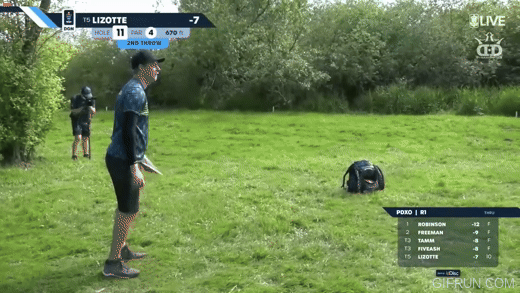Brychanus
* Ace Member *
There is definitely a lot to be said for cutting out the thinking and swinging that thang freely.View attachment 338920View attachment 338919View attachment 338918
Those 3 pics are from his introduction video where he does a short drive. The yellow line is where I would see his tilted axis. In the last pic it is a little weird, because he still has both feet on the ground but I picked that position because it shows him in his doorframe position.
My impression is that the steps he is taking are really short and lack weight. Watching him it feels like he is tiptoeing and his lower body is disconnected from his throw.
In the leftmost pic he is already turned backward/south when he should be squared up above his left foot. The left foot is also turned already which will make it really difficult for him to push off of it/get leverage against his instep.
In the middle pic he would fall over if he pushed off his drive leg. The stance is too narrow and his knee is angled inwards (like mine).
In the rightmost pic his knee is left of his front hip. Swiveling on top of that hip wont work well. He also takes a massive stagger.
His shoulders look a little flat to me, he doesnt have a lot of tilt in this throw. This might also be because of the short drive he takes here. He also barely drops into his plant, instead staying upright the whole time.
First time doing this, so likely to be very wrong. Im open to criticism tho, if you want to point something out.
I also agree with Jaani here, but wanted to take you (Brychanus) up, trying to find something out about Weissmans move.
Happy to chat more. I think I'd see the axes similarly. Fundamentally any time the balance line is not well-connected from top of head to foot, problems ensue.
Steps: lacking weight is a good observation. I think he does get a very firm/heavy crush and resist in the plant which is where some of the late power and quickness comes from, but otherwise not. I guess recently I've been trying to pay attention to the continuum from Paul Oman steps to Sidewinder Elephant steps to Dickerson full tilt runs. What they all have in common is very high leverage and ground contact/ground force reaction, I'd guess.
Posture is possibly turned too far back compensating for the balance issue. You do see some forms that are quite closed off the whole way (e.g., Dickerson) but they still are unlikely to use Weissman balance.
Stagger to me also looks compensatory for being in opposite tilted balance off the rear side.
All again just in the spirit of curiosity/learning, here's a writeup I did elsewhere. This is another example of how you can observe balance and weight shift mechanics problems that occur in throws just by looking at drill motions, e.g. starting around 1:34 here. All of these apply to his throw.
Here is a reference figure I marked up:

Weissman:
1. Has an open shoulder line, open plant leg/hip, and too flat hip orientation in his posture that requires him to rotate his hips back rather than shift them like walking. This already account for why you see rightward releases. He's throwing "over the top," and/or compensating for it in his plant as I will show. When I do/used to do this move, the balance is also fundamentally tilted in the opposite direction as aggressive athletic motion or a full-speed box step. Everything that happens afterward is a compensation.
2. This is classic power stance and trapping your center and spine between the feet. He should not have to stand in this position to show his transition move. He should be able to stand freely in balance in the tilt no matter where he is. Like Steve Pratt at 4:00. Almost everyone does this wrong, I've found.
3. Compensating posture for throwing "over the top." This is one of the most common misinterpretations of the tilted axis. Notice that Weissman's brace has already shunted his shoulder "up" posturally, his arm is on a strictly "linear" plane toward the trajectory, his hips are relatively still flat, his rear arm is dangling behind rather than collecting him forward into the shift, and his rear heel is pointed farther back from the target rather than collected toward it. This is not classic "squishing the bug," but it is a species of spin-shift. Simon's move functions much closer to a seabas dingle arm adapted for a more horizontal plane.
4. Practice swing afterimages are honest. Brian is showing you the result of swinging with an arm partially decoupled from his shoulder, which is why it is swinging lower. Because he isn't encoding good posture and balance and is swinging over the top, the plane keeps his shoulders on the unnatural "shunted up" trajectory rather than the way Simon's "swings" ("pulls", w.e.) over his plant knee, and his whole arm chain follows that momentum path into follow through. Look at the rear foot again.
Last edited:




